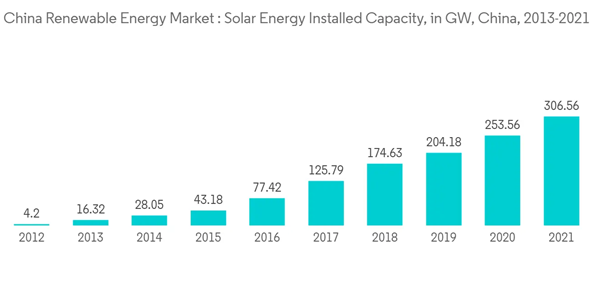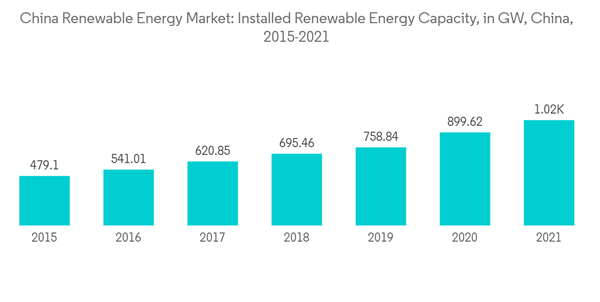The Chinese renewable energy market is expected to witness a CAGR of more than 8.7% during the forecast period.
This product will be delivered within 2 business days.
Key Highlights
- Over the long term, the primary drivers for the market include government initiatives to reduce dependency on fossil fuels to stabilize CO2 emissions and ensure a clean and efficient form of energy.
- On the other hand, delays in subsidy payments, interference in the market trading and pricing by local governments, and a plan to increase coal-fired power generation are likely to hinder the market growth during the forecast period.
- Nevertheless, China, the world’s largest energy consumer, plans to reduce its CO2 emission to 5150 million tons by 2035 and 2,600 million tons by 2050. Moreover, the Chinese government plans to increase the share of renewable energy in its energy mix to nearly 37% by 2035 and 58% by 2050. Thus, the country’s objective of reducing CO2 levels and increasing renewables’ share in the energy mix is expected to create an opportunity for the market to grow.
China Renewable Energy Market Trends
Solar Energy Segment to Witness Significant Growth
- Solar energy is among the fastest-growing renewable energy segments in the country. The country has been following a largely subsidy-based model to encourage the adoption of new technology. However, the Chinese government plans to eliminate all feed-in tariffs and subsidies for solar PV, even in the distributed generation segment. Similar non-subsidy models of business in Europe in countries like Germany and the Czech Republic have failed to deliver.
- Solar energy has the potential to become a significant energy source for power consumption across China. Favorable government policies, the declining price of solar modules, and agreements to reduce the increasing carbon footprint are prominent factors supporting market growth.
- The Chinese market grew with 54.9 GW of newly installed PV capacity in 2021, representing more than 30% of the newly added PV installations in 2021 globally. Further, as of May 2022, China’s National Energy Administration (NEA) has announced that nearly 108 GW of new solar capacity will be connected to the grid by the end of 2022, nearly double the capacity additions in 2021.
- Further, in early 2022, the China Photovoltaic Industry Association (CPIA) announced the industry is expected to add between 83 GW-99 GW of new capacity annually by 2025. This will likely have massive deployments in the Chinese solar PV industry during the forecast period. According to NEA, solar investments in China have already reached RMB 29 billion (USD 4.4 billion) in the first four months of 2022.
- The amount of solar power installed in China as of 2021 exceeded 300 gigawatts. The country has made significant strides in building its solar power capacity in the past decade, increasing cumulative capacity from only 4.2 gigawatts in 2012 to 306.56 gigawatts by 2021.
- Therefore, the solar energy sector is expected to witness significant growth in the country during the forecast period and beyond due to the factors above.
Increasing Shift Toward Renewable Energy Expected to Drive the Market
- As of 2021, China is one of the global leaders in renewable energy deployment. The country’s total renewable energy capacity reached 1,020 GW in 2021, representing an increase of approximately 13.4% compared to the previous year’s value. Hydropower, solar, and wind are the major renewable energy sources in the country.
- In the 13th five‐year plan, China launched the idea of an energy revolution with the aim to develop a clean, low‐carbon, safe, and efficient energy system by 2050. Since then, there has been significant growth in the country’s renewable energy sector.
- Renewable energy sources accounted for 14.95% of the primary energy consumption mix in 2021. Similarly, electricity generation from hydro and non-hydro renewables accounted for more than 27.7% of the electricity generated in the country in 2021.
- Among all the renewable energy sources in the country, hydropower accounted for more than 38.3% of the installed renewable energy capacity in the country in 2021. Wind energy is the second-largest renewable energy source (accounting for 32%), followed by solar energy (accounting for 30.1%) and bioenergy (accounting for 2.8%) in 2021.
- China’s hydropower installed capacity reached 391 GW, representing an increase of 5.6% compared to the previous year. China dominated the world in hydropower capacity addition in 2021 with the addition of 20.8 GW of hydropower.
- In December 2022, the country’s second-largest hydropower project, only behind the Three Gorges Project, was completed on the Yangzte River. The Baihetan hydropower plant is equipped with sixteen 1-gigawatt (GW) turbines and will generate 62.44 billion kilowatt-hours (kWh) annually, which could save about 90.45 million tons of coal a year and cut annual carbon dioxide emissions by 248.4 million tonnes.
- Apart from hydropower and solar energy, China is one of the largest wind power markets globally, with a total installed capacity of 310.6 GW at the end of 2021, with the onshore region accounting for about 92% of the full share. China, the world’s largest country in onshore wind power capacity, accounts for 40% (310.6 GW) of the total global installation. It is the largest with respect to installed offshore wind power capacity, with a share of 48% (27.7 GW) globally at the end of 2021.
- The country is also planning to build the world’s largest wind farm with a capacity of 44.3 GW. The wind farm is proposed to be located in the Taiwan Straight, Operating between 75 and 185 kilometers offshore. The construction of the project is expected to start by 2025.
- Hence, increasing investments in the renewable energy sector are expected to aid the market’s growth.
China Renewable Energy Industry Overview
The Chinese renewable energy market is fragmented. The key players in the market (in no particular order) include Sinohydro Corporation, China Yangtze Power Co. Ltd, Xinjiang Goldwind Science Technology Co. Ltd, JinkoSolar Holdings Co. Ltd, and Tina Solar Ltd, among others.Additional Benefits:
- The market estimate (ME) sheet in Excel format
- 3 months of analyst support
This product will be delivered within 2 business days.
Table of Contents
1 INTRODUCTION
4 MARKET OVERVIEW
5 MARKET SEGMENTATION
6 COMPETITIVE LANDSCAPE
Companies Mentioned (Partial List)
A selection of companies mentioned in this report includes, but is not limited to:
- Sinohydro Corporation
- China Yangtze Power Co. Ltd
- Xinjiang Goldwind Science Technology Co. Ltd
- Dongfang Electric Corporation Limited
- Sinovel Wind Group Co., Ltd
- JinkoSolar Holdings Co. Ltd
- Tina Solar Ltd
- JA Solar Technology Co. Ltd
- China Petroleum Bio-Energy Company Ltd
- Wuxi Suntech Power Co. Ltd
Methodology

LOADING...










